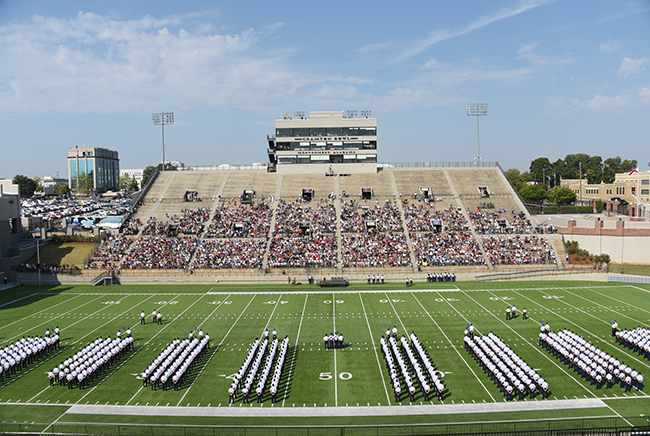
The Air Force's newest commissioned officers from the Officer Training School class 19-07 form up on the Cramton Bowl football field on Sept. 27, 2019, in Montgomery, Ala. Air Force photo by SSgt. Quay Drawdy.
Officer Training School graduated its largest-ever cohort since OTS became part of Air University—OTS Class 19-07, nicknamed the Godzilla class—on Sept. 27
A total of 651 students graduated in the ceremony, out of the total class of 800. About 149 other trainees finished earlier through a special off-ramp program for certain non-line officer trainees, and a handful of students either dropped out or didn’t qualify to walk at the ceremony, an Air University spokesperson told Air Force Magazine.
The class was so big that the ceremony had to be held at the Cramton Bowl in nearby Montgomery, Ala., in order to accommodate all of the graduates and their supporters, instead of at Maxwell Air Force Base’s parade field. The Air Force Thunderbirds Demonstration Team performed a flyover at the graduation’s conclusion.
For this class, OTS tripled the amount of seats available for active duty officers, going to 500 from about 170. Because the class was so large, it was split between two training squadrons. The graduating class beat a record set just about six months before, when a class of 340 officers graduated.
The Godzilla class was larger than usual for two reasons, OTS Commandant Col. Peter Bailey told Air Force Magazine in a Sept. 27 interview.
First, he said, OTS took on approximately 150 more students than usual to make up for a shortfall in officers being produced by the Reserve Officer Training Corps and the US Air Force Academy. OTS’ shorter course length gives it more flexibility to accommodate additional students to help meet time-sensitive accession needs, he explained.
Next, he said, timing mattered. While the school normally tries to stagger start dates for its classes so they’re eight weeks apart, the Godzilla cohort was essentially composed of two OTS classes held simultaneously to graduate the officers by the Sept. 30 end-of-fiscal-year deadline, he explained.
The mass of students posed logistical hurdles—like finding spaces at Maxwell that were big enough to accommodate the entire group in a single, auditorium-style room—but Bailey said the quality of the education the cohort received was not compromised by its size.
“That’s the one thing that we will not sacrifice when it comes to the balancing act between quantity, meeting the Air Force’s needs for lieutenants and officers, and the need for producing officers who are equipped and ready to win,” Bailey said. “We will never sacrifice that and, in fact, I can guarantee you that because the class was so big, because the class had so much diversity, that these officers got even more of an experience that the normal person gets going through the Academy or ROTC because of the diverse nature of our students.”
According to Bailey, OTS takes a unique approach to diversity.
“When we talk diversity most of us want to pigeonhole gender, race, nationality, but when OTS speaks of demographics and diversity, we look at diversity as experience,” he explained.
From the trainees’ ages and professional or service backgrounds, to the components they call home and their Air Force specialties, Bailey said airmen enrolled in OTS bring significant variety to Air Force.
“I would challenge anybody, I mean, you can try to make diversity be about gender and race, nationality, but what we hang our hat [on] here at OTS is diversity of experience, diversity of component, and diversity of where you’re going and what you’re gonna do in the Air Force, whether it’s line or non-line-type specialities,” Bailey said.
Editor’s Note: This story has been updated for clarity about historic OTS class sizes.
